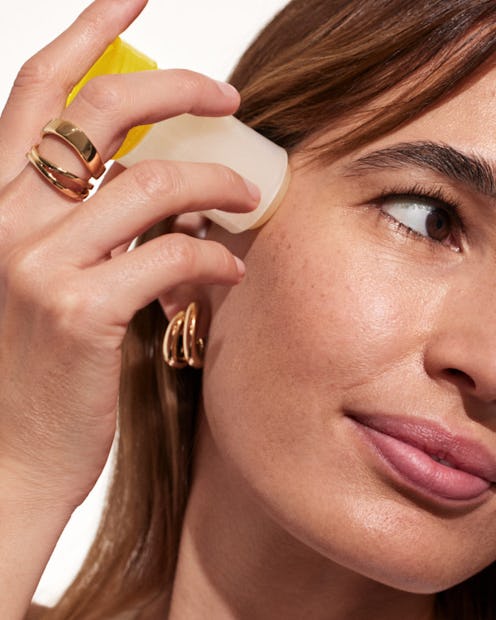(Skin)
Every Way To Reapply Sunscreen This Summer & Beyond
Including makeup-friendly options.

Here’s the good news: SPF application (and reapplication) isn’t rocket science — in other words, it’s relatively straightforward. But it’s also absolutely necessary, and all the more so during the late spring and summer.
Jodi LoGerfo,D.N.P., a New York City-based doctor of nursing practice certified in family medicine and dermatology, recommends using between one-fourth to one-half teaspoon of a broad-spectrum sunscreen with an SPF of 30 or higher every single morning. For those of us who don’t keep our measuring spoons handy, experts say between two to three fingers’ length worth of sunscreen should do the trick. One piece of colloquial advice that’s easy to follow: If you feel like you put on too much sunscreen, that’s probably a good indicator you have on the right amount. This first application is essential — rain-or-shine, come hell or high water.
From there, Dr. Michael I. Jacobs, M.D., a board-certified dermatologist and clinical associate professor of dermatology at Weill Cornell Medical College in New York City, suggests reapplying every four hours or so — and every two hours if you’re sweating a lot or swimming. And while that four-hour rule really should be followed every single day, it’s especially important in the warmer months, when our sun exposure is greatest.
Listen, we get it. It’s not just the fact that SPF reapplication is inconvenient, it can feel downright disruptive, especially if you’re wearing a full face of makeup. But with today’s abundance of SPF offerings, reapplication is easier — and more foundation-friendly — than ever.
Ahead, TZR breaks down every single way to reapply your sunscreen. And because there are just so many ways to do it, we’ve split up reapplication methods into two different tiers, from easiest and most effective to better than nothing.
The Big Three: Powdered Sunscreen, Sprays, and Sticks
Think of SPF powders, sprays, and sticks as the big three of sunscreen reapplication — they’re reliable, easy to use, accessible, and effective.
Powder Sunscreen
Powdered sunscreens offer the Holy Trinity of summertime benefits in a simple, portable format, setting makeup, sopping up excess oil and moisture on the skin, and delivering a potent dose of SPF upon application. Because it’s designed to go over makeup — not disrupt it — powdered sunscreen makes touching up your makeup and layering on protection a breeze. And today’s formulations are as advanced in their protection as they are in their complexion benefits. Dermatologist-approved favorites include:
Sunscreen Spray
For the powder- (and effort-) averse, a lightweight SPF facial spray formula might just be your perfect match. The hands-free option offers a sunscreen boost and cool little pick-me-up all in one. Some are even specially formulated to set makeup, making it the ultimate multitasker for those on the go. While Jacobs suggests following the product’s specific instructions for use, he says sprays should typically be shaken before use, held around eight inches from the face, and evenly dispersed across the skin to ensure proper coverage. The best SPF sprays include the following:
Sunscreen Stick
Stick options are perhaps the most user-friendly — simply glide and go — though they can be a bit more finicky when applied over makeup (well, most of the time, more on that in a bit). And, because they’re applied directly to the skin, experts say it’s important to regularly disinfect them. A thorough swipe of an alcohol wipe should do the trick. Still, sunscreen sticks remain among a favorite SPF method thanks to their pocket-friendly size, ease of use, and comfortable, nondrying feel.
In A Pinch: Makeup With Sunscreen
Jacobs says it’s always best to use a true sunscreen product, but if you can only get your hands on makeup, it’s better than not reapplying at all. It’s not exactly a sweeping endorsement but in a pinch, makeup with SPF can work. That said, it’s important to consider the type of product you’re using – not all categories are intended for your entire face, so be sure you’re still getting adequate coverage all over. Dosage is another factor: Just because a formula says it’s SPF 30 doesn’t mean you’re getting the full effects every time, unless you apply the right amount. Imperfect, yes, but better than skipping SPF all together. Below, some of our favorite makeup products with sun protection benefits.